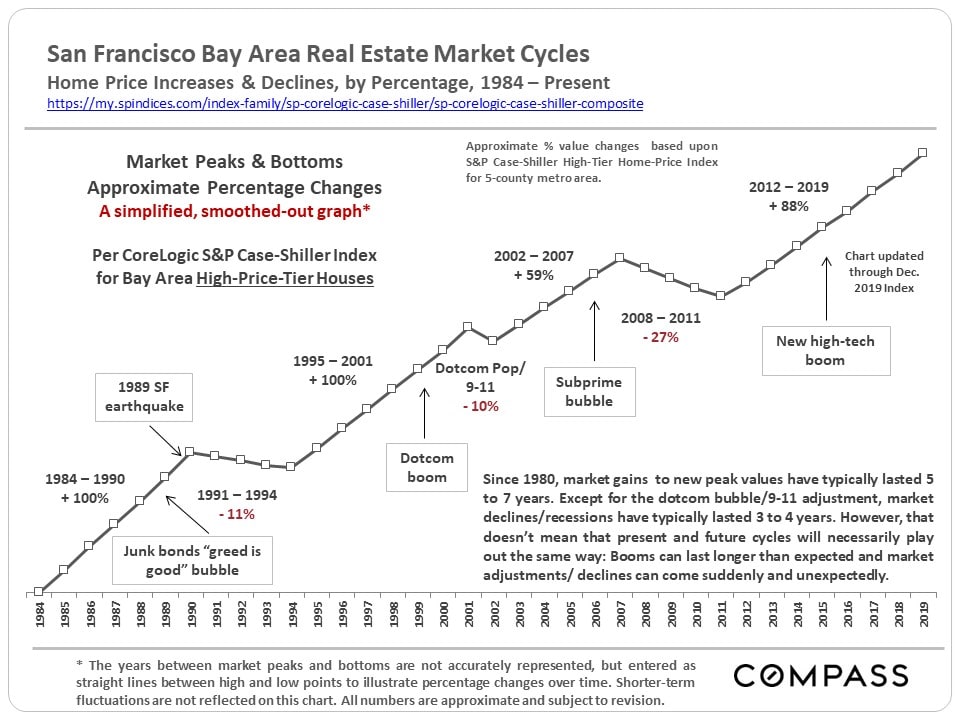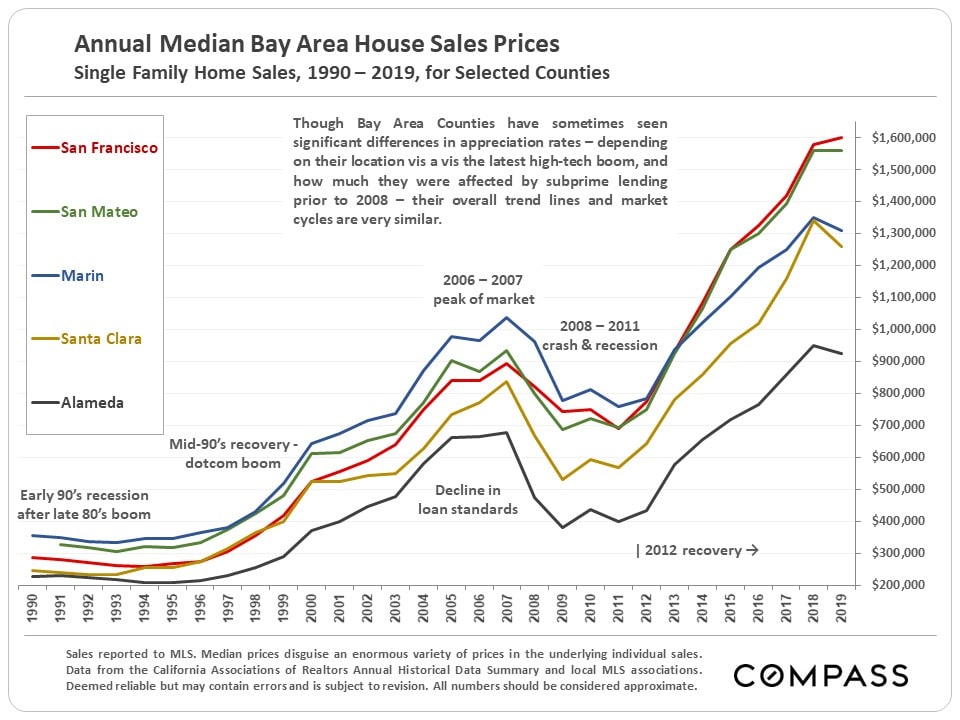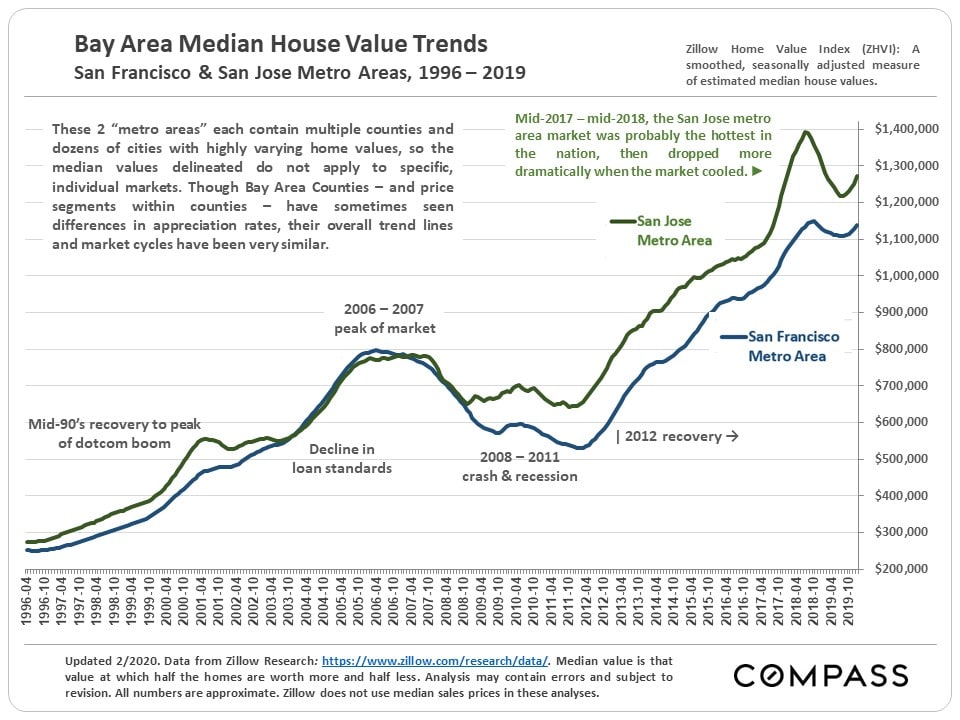We realize there are much more important things than real estate right now, but I know many of you are curious about what is happening in the real estate market. This article was written before the coronavirus – in fact, the first version was written over 10 years ago by our chief market analyst to help place the 2008 crash into context. At this point, we cannot know how the current crisis will play out. We will try our best to provide useful information on market trends and conditions.
This first chart is a very simplified, smoothed-out look at Bay Area market cycles for higher-price-tier homes using data from the S&P CoreLogic Case-Shiller Home Price Index. It is a very approximate overview of hundreds of different neighborhood markets - whose trends up and down were broadly similar, but whose details, such as specific appreciation percentages, varied.

The following chart uses the median house sales price trends of 5 Bay Area counties to illustrate a simple fact: The entire Bay Area generally follows the same broad trend lines in market cycles. Of course, there are differences by location, property type, and price segment, but overall cycles are very similar. (We only picked 5 counties as samples, because adding all of them will over-clutters the chart.)

This chart uses yet another market-value tracking algorithm looking at the 2 biggest, multi-county "metro areas" in the Bay Area. Since they reflect multiple counties of highly varying values, the prices themselves don't really reflect the prices of any specific market. The reason for the bigger drop post-2008 in the SF metro area is that portions of its 5-county area were more deeply impacted by the subprime lending crisis than the counties comprising the San Jose metro area.

Financial-market cycles have been around for hundreds of years, from the 1600’s Dutch tulip mania through our recent speculative frenzy in crypto-currencies. Each market cycle has different characteristics in underlying causes and effects, and how it ultimately plays out in its specifics, but there are fundamental similarities in all of them, providing more context as to how the market works over time.
Human beings have always been worried about (or terrified of) the future, and we have constantly attempted to predict what it holds. However, whether using priests, oracles, astrologers, economists, analysts, or media pundits, we show no aptitude as a species for having the ability to do so with any accuracy. In 2012, a Nobel-Prize-winning economist, famous for housing market analysis, said that the U.S. real estate market might not recover "in our lifetimes." In hindsight, we now know that the recovery had already begun in some markets such as San Francisco. In 2015, during a period of financial market fluctuations and a slowdown in our local high-tech boom, a well-respected Bay Area economist predicted that there would soon be “blood in the streets of San Francisco.” Within cycle phases, there are often shorter-term periods of economic, ecological, and political volatility which then pass. In 2016-2018, housing and stock markets soared higher and the high-tech boom strengthened again.
Our smartest experts can’t get it right, much less the thousands of glib, confident forecasts by utterly unqualified individuals reported on in the media every month. We can't even remember the mistakes of the recent past – one reason why we don't seem to be able to escape the curse of recurring cycles – much less foretell what's going to happen tomorrow. This leads to the next point.
It is extremely difficult to predict when different parts of a cycle will begin or end. There is no rule regarding how long the different parts of a market cycle will last. Boom times, even periods of “irrational exuberance,” can go on much longer than expected, or get second winds, with huge jumps in values. On the other hand, negative shocks can appear with startling suddenness out of nowhere, often triggered by unexpected economic, political, or even ecological events that hammer confidence, adversely affect a wide variety of market dominos, and then balloon into periods of decline and stagnation. These negative adjustments can be in the nature of a bubble popping, the slow deflation of a punctured tire, or some combination of the two.
Going back many decades, all the major Bay Area recessions have been tied to national or international economic crises. Considering the fundamental strengths of the local economy, absent a major natural disaster, it is unlikely that a major downturn would occur due simply to local issues. However, local issues can exacerbate a cycle: The 1989 earthquake intensified the effects of the national recession in the early 1990s; our greater exposure to dot-com businesses produced a spike up and down with the NASDAQ bubble & 2000-2001 crash, and our current high-tech boom poured fuel on our up-cycle during the current recovery.
All bubbles are ultimately based on irrational exuberance, runaway greed, criminal behavior, or all three mashed up together. Whether exemplified by junk bonds, stock market hysteria, gorging on debt, a corporate Ponzi scheme mentality, an abandonment of reasonable risk assessment, and/or incomprehensible and dishonest financial engineering, the bubble is relentlessly pumped bigger and tighter.
However, the 2008 crash was abnormal in its scale and much greater than other downturns going back to the Great Depression. The 2005-2007 bubble was fueled by home buying and refinancing with exorbitant, unaffordable levels of debt, promoted by predatory lending practices such as deceptive teaser rates, no-down-payment loans, and an abysmal decline in underwriting standards. The market adjustments of the early 1990s and early-2000’s saw declines in Bay Area home values in the range of 10% to 11%, as compared to the terrible 2008 - 2011 declines of 20% to 60%. (Bay Area prices are now above their 2007 peaks.)
Whatever the phase of the cycle, many people think it will last forever. Going up: “The world is different now, profits don’t matter, the rules don’t apply anymore, and there’s no reason why the upward trend can’t continue indefinitely.” Well, it turns out that the rules do still apply, and up-cycles always end sometimes. And when the market turns: “Homeownership has always been a terrible investment and the market will not recover for decades.” But the economy mends, the population grows, people start families, inflation accumulates over the years, and the repressed demand of those who want to own their own homes builds up. In the early eighties, mid-nineties, and in 2012, after about 4 years of a recessionary housing market, this repressed demand jumped back in – or "exploded" might be a better description – and home prices started to rise again. The nature of cycles is to keep turning.
As long as one doesn’t have to sell during a down cycle, Bay Area homeownership has almost always been a good or even spectacular investment (though admittedly if one does have to sell at the bottom of the market, the results can be quite painful). This is due to the ability to finance one’s purchase (and refinance when rates drop), certain tax benefits, the gradual pay-off of the mortgage (the “forced savings” effect), inflation, and long-term demographic and appreciation trends.
The best way to overcome cycles is to buy a home for the longer term, one whose monthly cost is readily affordable for you now, ideally using a long-term, fixed-rate loan (refinancing to lower rates when that option opens) while keeping an adequate financial reserve for emergencies - and then resisting the urge to use one’s home as an ATM during times of significant appreciation. If one keeps to those rules, then it is usually true, quoting a NYT editorial, “Renting can make sense as a lifestyle choice... As a means to building wealth, however, there is no practical substitute for homeownership.”


